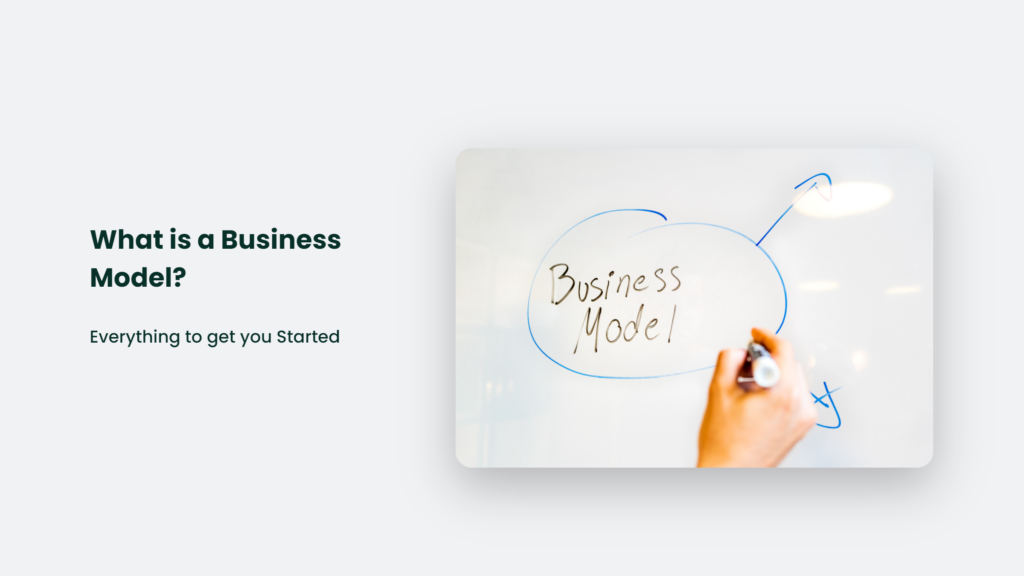We all talk about “business models” like we know what the hell we’re all talking about. But do we really?
Most people can’t even agree on a definition. And those who do often get lost in a cesspool of MBA speak and nonsense jargon that makes you want to punch yourself in the face.
So I’m going to try and explain this whole “what is a business model” thing in plain English so we can all get on the same damn page.

What is a Business Model?
At its core, a business model is how a company makes money. It’s that simple.
It lays out how a business delivers value to its customers at a profit.
Here are the critical components of a business model:
- Value proposition – The value the company delivers to customers. It solves a problem or satisfies a need.
- Customer segments – The different groups of people or organizations the company aims to reach and serve.
- Channels – How the company communicates with and reaches its customer segments to deliver its value proposition.
- Customer relationships – The relationship the company establishes with each customer segment.
- Revenue streams – How the company makes money from each customer segment.
- Key resources – The assets required to create and offer the company’s value proposition.
- Key activities – The company’s actions to operate its business model.
- Key partners – The network of suppliers and partners required to deliver the value proposition efficiently.
- Cost structure – The costs incurred to run the business model.
Let’s look at a simple example:
A lawn mowing business offers a value proposition of convenient and affordable lawn mowing services. Its customer segment is homeowners.
The business acquires customers through promotions on community bulletin boards (a channel). It establishes an automated service relationship with customers.
The revenue stream comes from per-service fees paid by homeowners. The essential resources are lawnmowers, trucks, and employees. The key activities are mowing lawns and scheduling/routing.
The key partners are gas stations and equipment repair shops. The cost structure includes labour, equipment, and gas.
It shows how the lawn mowing company creates value, reaches customers, and makes money. That’s its business model.
Why Do Business Models Matter?
At first glance, this whole “business model” thing might seem irrelevant.
After all, if you provide something people want, you can make money.
Wrong.
The business model matters because it plays a major role in whether a company succeeds or fails.
Here’s why:
It defines the company’s competitive position. The business model shapes how a company competes in the market and differentiates itself. A lawn mowing company with a mobile app has a different competitive position than one dispatching crews by phone.
It affects profit margins. The business model influences how much it costs to operate a business and how much can be charged per transaction. High-touch consulting services have different margin economics than automated SaaS companies.
It determines scalability. Some business models are easier to scale up than others. Software companies can acquire more users with minimal incremental cost. Service businesses require hiring more people.
It drives innovation. The business model sets the company’s focus for innovation. For example, a restaurant innovates around food quality and dining experience. Software companies innovate around new features.
It establishes defensibility. Business models can create competitive barriers and “moats” that make a company difficult to displace. Oligopolies, networks, and subscription models all enable defensibility.
In short, the business model is the very foundation of how a company operates and competes. It’s kind of a big deal.
Breaking Down the Most Common Business Models
There are many types of business models out there. Here are some of the most common ones:
Manufacturing
This model produces goods to be sold, usually in large quantities. Companies like GE, Boeing, and Toyota are manufacturers.
Value comes from efficient production processes to minimize costs so prices can be lower. Companies innovate around production methods and supply chain management.
Retailer
Retailers purchase products from suppliers and resell them to consumers. It includes companies like Walmart, Costco, and Best Buy.
Value comes from offering low prices and a wide selection. Innovation focuses on store formats, supply chain management, and enhancing the shopping experience.
Wholesaler
Wholesalers purchase products from manufacturers and sell them to retailers, who then resell them to consumers. Examples are food distributors Sysco and US Foods.
Value comes from an efficient distribution that provides retailers access to many products. Wholesalers innovate with warehouse automation and logistics management.
Subscription
This model charges recurring fees for continued access to a product or service. Companies like Netflix, Salesforce, and Dollar Shave Club use subscriptions.
Value comes from convenience and discounts for loyal subscribers. Innovation focuses on original content, new features, and pricing promotions.
Marketplace
A marketplace facilitates transactions between buyers and sellers. eBay, Airbnb, Uber, and Fiverr operate marketplaces.
Value comes from convenient access to sellers/buyers and trust in the platform. Innovation focuses on tools, services, and policies that remove transaction friction.
Advertising
Media companies provide free content to users and sell advertising space to businesses looking to reach those users. Google, Facebook, and BuzzFeed use advertising models.
Value is matching advertisers with their target audiences. Innovation focuses on understanding users and offering better ad targeting.
Many other models include franchising, licensing, freemium, and more. But these cover some of the most common ones.
The key is understanding how each model creates value, reaches customers, and makes money uniquely.
How to Choose the Right Damn Business Model
Picking the right business model is a big strategic decision. Here are some factors to consider:
- Target customers – Who are you creating value for? The model must resonate with their needs.
- Capabilities – What resources and processes does your business have to work with? Play to your strengths.
- Value proposition – How will you differentiate your offering and stand apart from competitors?
- Cost structure – What will it cost to produce and deliver your offering? The model must have attractive unit economics.
- Revenue model – How will you sustainably capture value to profit from your idea?
- Scalability – How easily can you acquire more customers with minimal incremental cost?
- Defensibility – Will your model create barriers to imitation and displacement by rivals?
There are tradeoffs to evaluate for each option. Building competitive barriers with a subscription model limits market size. Advertising and marketplaces can scale rapidly but offer less control.
It’s about finding the right balance for your specific business goals and situation.
Don’t just copy what everyone else is doing. Be thoughtful about what model truly aligns with your strategy.
Turning Your Business Model Into Cold, Hard Cash
Once you have a business model, it ultimately comes down to execution.
Here are some key questions to drive business model performance:
- How can we get operating costs as low as possible?
- Where can we establish recurring revenue streams?
- How can we maximize customer lifetime value?
- What partnerships or channels can expand our reach?
- How can we get our average order values higher?
- Where are waste and inefficiencies we can eliminate?
- How can we make customers more habitual and less likely to switch?
- How can we turn one-time buyers into loyal repeat purchasers?
- How can we leverage customer data and insights for innovation?
- How can we align employee incentives with desired business outcomes?
There are two levers to profitability: increasing revenue and decreasing costs. The business model should be constantly optimized on both fronts.
Examples of Successful Business Models in Different Industries:
E-Commerce:
- Amazon is an online marketplace and retailer with diverse revenue streams, including commissions, advertising, subscriptions, and more. Highly scalable.
Software:
- Adobe– Pioneer of the subscription model for creative software. Recurring revenue with high margins.
Hospitality:
- Airbnb – Online marketplace for short-term rentals and experiences. Charges host and guests a fee.
Consulting:
- Accenture – Sells expertise and services to help clients improve operations and technology. Focuses on value-based and recurring revenue.
The most successful models tend to leverage technology to enable recurring revenue streams, new customer experiences, and scalable reach. But traditional models like retail and consulting can also thrive by focusing on core value propositions. The key is aligning the business model with the company’s specific strengths and industry dynamics.
Isn’t “Business Model” Just a Fancy Way to Say How You Make Money?
Yep, pretty much.
At the end of the day, the business model explains how you create, deliver, and capture value.
All the academic definitions and frameworks need to be revised.
So, here’s a simple way to think about it:
Your business model = how you solve a problem or satisfy a need + how you get paid to do it
That’s it.
Of course, the details and nuances matter. But a great business model boils down to providing something people want + a way to profit from it.
Everything else is just commentary.
So don’t let the business schools confuse you. Focus on building a product users love and a model that turns their satisfaction into sustainable profits.
That’s all a great business model really is.
Frequently Asked Questions:
What are some examples of bad business models?
Bad business models don’t create enough value for customers to profit sustainably from the price charged. MoviePass and Pets.com are examples of business models that didn’t work.
What business models are most profitable?
Platforms, subscription services, and companies with strong brands tend to be very profitable. They create recurring revenue and competitive barriers.
How often should you change your business model?
Tweak it constantly, but dramatic changes are risky and disruptive. Only completely revamp your model if the old one is fundamentally flawed.
Bottom Line:
Hope this helps provide some useful context on what the hell a business model actually is! The concept may seem complex but just focus on creating real value for customers and profiting from their satisfaction.




